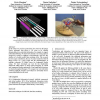Free Online Productivity Tools
i2Speak
i2Symbol
i2OCR
iTex2Img
iWeb2Print
iWeb2Shot
i2Type
iPdf2Split
iPdf2Merge
i2Bopomofo
i2Arabic
i2Style
i2Image
i2PDF
iLatex2Rtf
Sci2ools
ISMAR
2006
IEEE
2006
IEEE
Interactive context-driven visualization tools for augmented reality
In this article we present an interaction tool, based on the Magic Lenses technique, that allows a 3D scene to be affected dynamically given contextual information, for example, to support information filtering. We show how elements of a scene graph are grouped by context in addition to hierarchically, and, how this enables us to locally modify their rendering styles. This research has two major contributions, the use of context sensitivity with 3D Magic Lenses in a scene graph and the implementation of multiple volumetric 3D Magic Lenses for Augmented Reality setups. We have developed our tool for the Studierstube framework which allows us doing rapid prototyping of Virtual and Augmented Reality applications. Some application directions are shown throughout the paper. We compare our work with other methods, highlight strengths and weaknesses and finally discuss research directions for our work. CR Categories H.5.1 [Multimedia Information Systems]: Artificial, augmented, and virtual r...
| Added | 12 Jun 2010 |
| Updated | 12 Jun 2010 |
| Type | Conference |
| Year | 2006 |
| Where | ISMAR |
| Authors | Erick Méndez, Denis Kalkofen, Dieter Schmalstieg |
Comments (0)

